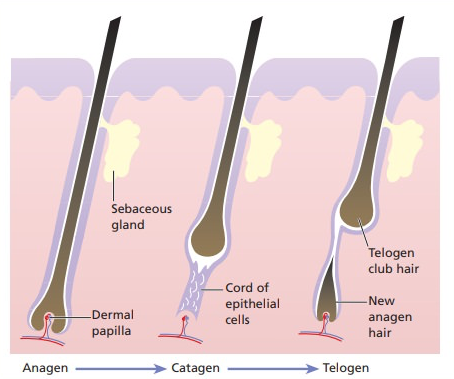The Hair Cycle
THE HAIR CYCLE & HAIR LOSS
Normal hair grows through a hair cycle that has three stages. The growth phase, or anagen phase, is the longest phase of the hair cycle, with 80 to 90% of the hair on our scalp in this phase. In the next stage called the catagen phase, the hair bulb detaches from the blood supply and is pushed from the scalp. In the last stage, the telogen phase, shedding occurs as the hair is released, leaving behind an empty follicle.
Each hair follicle is independent, going through the cycle at different stages as the other hairs. Hair problems occur when there is a disruption in the hair cycle.

What Is Hair Loss?
Hair loss also known medically as alopecia can be defined by shedding of hair, leading to an overall thinning that causes the scalp to be visible, or “balding”. Some people may also experience hair problems such as a change in the quality of hair or breakage of the hair shaft, which also results in an overall altered appearance of hair. Hair loss can happen to anyone and everyone under the sun. Everyone, male or female, elderly, middle aged-adults or children is considered susceptible when it comes to hair loss although at each age group, there are different underlying causes that results in the loss of one’s crowning glory.
Is my hair loss normal?
We may experience changes to our hair such as hair loss or thinning as we age, so be sure to distinguish the difference between normal changes and alopecia. Based on traditional textbook recommendations, 100-150 hair strands lost in a day is normal and they usually show up when you brush your comb through or after washing your hair. Bald patches on your scalp or more than 150 strands a day can be classified as abnormal hair loss. In my practice, I abide by this principle instead in evaluating individuals with hair loss — I ask patients to first quantify the usual amount of hair loss they experience, and then the current amount of hair loss. If there is an increase of at least 20% for a sustained period of at least 3 weeks, I would consider this significant and investigate/treat accordingly, even if they do not fulfil the >150 strands a day principle. The reason for this is that there is significant ethnic variation in hair follicle density, so loss of 100 hairs per day may be “normal” for those with naturally thick hair. On the other hand, individuals with less hair, may find that normal ranges from 30-50 strands instead.
How do dermatologists diagnose alopecia?
There are two major forms of hair loss – scarring or non-scarring alopecia.
Follicular orifices refer to the opening of hair follicles on the surface of skin. If follicular orifices are absent on the scalp, and the underlying scalp has a shiny white color, the hair loss is scarring. If follicular orifices are present, it is a form of non-scarring alopecia.
Non-scarring hair loss is the loss of hair without any presence of scarring in the scalp. Scarring alopecia leaves scar tissues on the scalp and may show signs of inflammation, redness or swelling. The commonest type of non scarring hair loss is androgenetic alopecia, otherwise known as female/male pattern baldness. Patients with androgenetic alopecia have high levels of sensitivity towards androgens, a type of circulating male hormone, on their scalps.
Effects of androgen include miniaturisation of hair follicles by increasing the rate of cell division, shortening the hair cycle and increasing the duration of the telogen phase.




Leave a Reply
Want to join the discussion?Feel free to contribute!